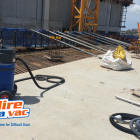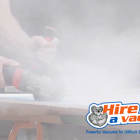Introduction
For years, vacuum filtration in the construction and painting/decorating industries has been a grey area. However, we hope to clear up some of these myths by highlighting Worksafe’s current guidelines.
Vacuums come in three main classes that represent their level of filtration. Worksafe’s guidelines specify the minimum required class for each purpose; we have compiled below a list of tasks, and which vacuum classes are used for them.

the three classes are ‘L’, ‘M’ and ‘H’ (Low, Medium and High Hazard).
The three classes are ‘L’, ‘M’ and ‘H’ (Low, Medium and High Hazard).
- Class L is the lowest hazard rating. It applies to materials that are not dangerous, such as food or cosmetics.
- Class M is used for materials that can be hazardous if they are not handled properly, but which can also be handled safely under certain conditions (for example some types of powdery substances).
- H-class filtration removes all particles larger than 100 microns from your product stream—even viruses!

H-CLASS FILTRATION
H-CLASS FILTRATION is used for the safe cleaning of hazardous materials. It uses a high vacuum, which is maintained by a special pump that creates an airtight seal around your filter media. The result is that it traps dust particles that are too small to be caught by ordinary vacuums, but which could otherwise contaminate your workspace or equipment.
Read more: The Best Types of Dust Collectors for Your Business
Silicia Dust (e.g. Concrete grinding)
“Use an H-class HEPA-filtered vacuum cleaner in accordance with Standard AS60335-2-69.”
Asbestos
“A vacuum cleaner for cleaning asbestos contaminated material should comply with AS 3544 Industrial Vacuum Cleaners for Particulates Hazardous to Health and must be labeled with a high hazard ‘H’ class symbol and the words ‘For asbestos use only’.” H-Class filtration can also be used in conjunction with other types of filtration methods (such as HEPA) to ensure.
M-CLASS FILTRATION
M-CLASS FILTRATION is used to remove solid particles from liquids. M-CLASS FILTRATION is also used to remove liquid particles from gases, and finally, M-CLASS FILTRATION may be used in order to separate both liquid and gas components.
L-CLASS FILTRATION
L-CLASS FILTRATION is the lowest hazard class of filtration. It is used for the filtration of non-flammable and non-explosive gases or vapors. The L stands for low hazard, but don’t let that fool you: there are still risks involved in using this type of equipment!
Read More: Hazardous dust in the workplace and how to handle it
ADDITIONAL INFORMATION
- Fine dust can clog filters quickly, so it’s a good idea to buy vacuums with the built-in vibrating auto-clean feature
- Ensure that vacuum cleaners are appropriately sized for each task, emptied regularly, and handled safely.
- Always use the correct type of disposable vacuum bags and be sure to dispose of them properly.
- Ensure power tools connected to the vacuums have their dust hoods in place, and that consumables such as sanding disks match up with them.
- Ensure that workers use the appropriate personal protective equipment (PPE) such as dust masks, gloves, and eyewear where required.
Conclusion
We hope that this article has helped you understand the difference between the three vacuum filtration classes.
For more information or to discuss your requirements, please contact us
Call our technical team now for a consultation. Toll-free +61 1800 438 822 or Email Us On bookings@hireavac.com.au.











